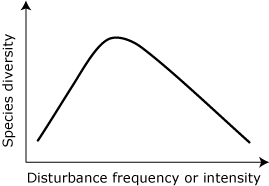Ecosystem Stability
Resistance and resilience: the relationship between stability and sustainability
Ecosystem stability is an important corollary of sustainability. Over time, the structure and function of a healthy ecosystem should remain relatively stable, even in the face of disturbance. If a stress or disturbance does alter the ecosystem is should be able to bounce back quickly.
Stability has two components:
Resistance - the ability of the ecosystem to continue to function without change when stressed by disturbance. Resilience - the ability of the ecosystem to recover after disturbance.
(Odum, 1989; Seybold et al, 1999)
Factors affecting stability:
- Disturbance frequency and intensity (how often and what kind of tillage)
- Species diversity (intercropping or rotations), interactions (competition for water and nutrients from weed species), and life history strategies (do the species grow fast and produce many seeds or slow with few seeds)
- Trophic complexity (how many functions are represented), redundancy (how many populationsA population is a group of individuals of the same species that live in the same geographic region. perform each function), food web structure (how do all of these groups interact)
- Rate of nutrient or energy flux (how fast are nutrients and energy moving in and out of the system or input:output efficiency)
Suggested practices to increase agroecosystem stability and function:
| Stability Factor | Examples | Suggested Factors |
|---|---|---|
| Disturbance (frequency and intensity) | ||
| Chemical | Fertilizers and pesticides | Account for mineralization of organic amendments, be aware of non-target effects of pesticides |
| Biological | Introduction of exotic or weed species | |
| Physical | How often and what kind of tillage | Reduced, minimum or no-till practices |
| Diversity | ||
| Species | Genetic resources (crop) or competition for water and nutrients (weeds) | Intercropping of varieties |
| Structure or habitat | Variety of plant heights (e.g. to increase niche space among insect predators) | Intercropping of species |
| Temporal | Variety of plants through time | Rotations |
| Complexity | ||
| Trophic groups | How many functions are represented | (For all types of complexity) Practices that improve habitat for soil |
| Redundancy | How many populations perform each function | Organisms, such as organic matter amendments, reduced disturbances |
| Food web structure | How do all of these groups interact | Increased diversity of resources and niches (habitat) (see above) |
| Nutrient or energy flux | ||
| How fast nutrients or energy move through the system | Low input, high organic matter, more... | |
| Input:Output efficiencies | Eliminate over-applications |
Disturbance and stability
An ecosystem disturbance can be natural or human induced stress. An example of a natural disturbance is a hurricane or a tornado. An example of a human-induced or anthropogenic disturbance is tillage or pesticide application.
Redundancy in ecosystem structure and function often infers stability on a system. For instance, if there is more than one (redundant) population of microbes that convert ammonium to nitrate and a disturbance wipes out one population, that function (nitrification) will continue to be performed by the remaining populations.
Because agroecosystems have reduced structural and functional diversity, they have less resilience than natural systems (Gleissman, 1998). The expected outputs from the system (yield) cannot be sustained without human inputs, therefore humans are a integral part of agroecosystems.
 A concept related to ecosystem stability is the Intermediate Disturbance Hypothesis, which states that the highest levels of diversity are supported at intermediate levels of disturbance (frequency or intensity). Diversity is usually defined in terms of species demographics (i.e., species richness or the number of species present in a given area), but functional definitions are not unprecedented.
A concept related to ecosystem stability is the Intermediate Disturbance Hypothesis, which states that the highest levels of diversity are supported at intermediate levels of disturbance (frequency or intensity). Diversity is usually defined in terms of species demographics (i.e., species richness or the number of species present in a given area), but functional definitions are not unprecedented.
Gleissman, S.R. 1997. Agroecology: Ecological Processes in Sustainable Agriculture. Ann Arbor Press, Chelsea, MI.
Odum, E.P. 1989. Ecology and Our Endangered Life Support Systems. Sinauer Associates, Inc., Sunderland, MA.
Seybold, C.A., J.E. Herrick and J.J. Brejda. 1999. Soil resilience: A fundamental component of soil quality. Soil Science 164:224-234.
